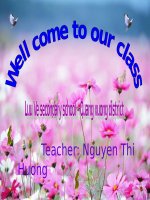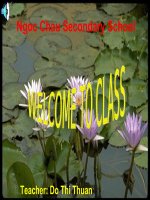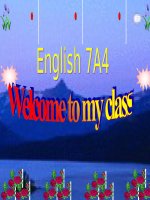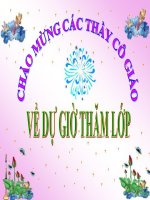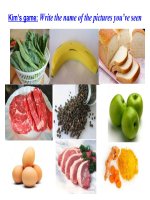- Trang chủ >>
- Y - Dược >>
- Vi sinh học
Unit 9. Cities of the world. Lesson 3. A closer look 2
Bạn đang xem bản rút gọn của tài liệu. Xem và tải ngay bản đầy đủ của tài liệu tại đây (133.8 KB, 6 trang )
<span class='text_page_counter'>(1)</span><div class='page_container' data-page=1>
<i><b>Period: 70</b></i>
<b>Unit 9: CITIES OF THE WORLD</b>
<b>A closer look 2</b>
<b>I. Objectives</b>
<i><b>1. Knowledge, Skills, Attitude: </b></i>
<i><b>a. Knowledge: By the end of the lesson sts can know the form and use of the Present perfect tense, then </b></i>
do the exercise correctly.
<i><b>- Vocabulary: the lexical items related to the topic “Cities of the world”.</b></i>
<i><b>- Grammar: The Past Simple</b></i>
<i><b>b. Skills: listening, speaking, reading and writing.</b></i>
<i><b>c. Attitude: Educate students know more about the cities, the countries and the continents in the world.</b></i>
<i><b>2. Capacity is formed and developed for students</b></i>
- Self – learning capability
- Communicative competence
<b>II. Preparation</b>
<i><b>1. Teacher: text book, extra board, cassette tape and real objects.</b></i>
<i><b>2. Students: textbook, notebook, workbook.</b></i>
<b>III. Students’ activities</b>
1. Warm up (5’)
<b>Sts’ and T’s activities</b> <b>Contents</b>
T: “We have recently talked a lot about interesting
facts in Viet Nam. Can you tell me which cities you
have visited more than once?”
Ss: Answer teacher’s question.
<b>Chatting</b>
<i><b>2. Knowledge formation activities (36’)</b></i>
<b>Sts’ and T’s activities</b> <b>Contents</b>
T: Gives some examples to help Ss to know how to
use the present perfect tense. (the usages, the
form...)
Ss: Listen and write down.
* Grammar: The present perfect tense.
Eg: I’ve been to most of the cities.
I have never been there.
I have visited Dalat twice.
* Formation:
(+) S + Have/ Has + PP
(-) S+ Haven’t/ hasn’t+ PP
(?) Have/ Has+ S + PP ?
IRREGULAR VERBS
Be - was/ were - been do - did - done
Have - had - had go – went - gone
Win - won - won sit - sat - sat
Eat - ate - eaten take -took - taken
<i><b>Note - Have you ever been to Dalat?</b></i>
- Yes, I have/ No, I have never been there.
T: Asks Ss to recall what Tom told Mai about in the
conversation in “Getting started”
- Has Ss underline all the verbs in the present
perfect tense. Then gives more examples.
- Uses the Grammar box to explain that the present
perfect is used to show that one has had or has
never had this experience.
- Notices the form, the past participle and the use of
<i><b>ever and never.</b></i>
<b>1. Listen again to part of the conversation. Pay</b>
<b>attention to the present prefect.</b>
T: Asks Ss to work individually to put the verbs in
brackets into the present perfect
T: Observes/helps when necessary and corrects Ss’
mistakes.
<b>Put the verbs in brackets into the present perfect</b>
*Key:
</div>
<span class='text_page_counter'>(2)</span><div class='page_container' data-page=2>
- More explain that the present perfect tense (It’s
not important to state the exact time). 2. has visited5- hasn’t been 4. has been
T: Asks Ss to remember the present simple.
( it describes a repeated action, a truth, goes with
adverbs of frequency …)
T: Asks Ss to work individually to put the verbs in
brackets into the present perfect or the simple
present.
- Lets Ss compare the answers with their friends
- Gives feedback as a class discussion.
<b>3. Write the correct form of the verbs. </b>
*Key:
1- Have you seen …I have seen...
2- go
3- have never been
4- clean
5- takes
6- has eaten
T: Elicits what there is in the photos: What can you
see?
- Read a book read
- Eat pho / noodles eaten
- Play football played
- Get A mark got
- wash his dog washed
- Asks them to give the past participles of these
verbs.
- Has Ss to write the full sentences then compare
with their partners
- Calls some SS to talk about what Tom has done
this week
<b>4. Write sentences to tell what Tom has done this</b>
<b>week.</b>
<b>*Key:</b>
1. He has read a book.
2. He has eaten pho / noodles.
3. He has played football.
4. He has got A mark.
5. He has washed his dog.
T: Lets Ss listen and repeat the survey questions in
the box- more explain some difficult information.
-Lets Ss go around the class.
- Take turns asking and answering the survey
questions.
-Asks Ss to report their results. Count the number
of “yes” answer to each question and find out what
the thing the most SS have ever done and the thing
that the least of them / or no one has done ...
<b>5. Class survey</b>
<i><b>3. Consolidation 4’</b></i>
T: Asks students to repeat the main contents of the lesson:
- The present perfect tense.
- The lexical terms related to the topic “Cities of the world”
<i><b>4. Using knowledge (option)</b></i>
<i><b>5. Further practice (option)</b></i>
<b>IV. Experience:</b>
………
………
………
<i><b>Period: 71</b></i>
<b>Unit 9: CITIES OF THE WORLD</b>
<b>(Communication)</b>
<b>I. Objectives</b>
<i><b>1. Knowledge, Skills, Attitude: </b></i>
<i><b>a. Knowledge: By the end of this lesson, students will able to identify landmarks in cities around the</b></i>
world and compare features of cities around the world.
<i><b>- Vocabulary: the lexical items related to the topic “Cities of the world”.</b></i>
<i><b>- Grammar: Comparatives of adjectives, Possessive case</b></i>
</div>
<span class='text_page_counter'>(3)</span><div class='page_container' data-page=3>
<i><b>c. Attitude: - Educate students know more about the cities, the countries and the continents in the world.</b></i>
<i><b>2. Capacity is formed and developed for students</b></i>
- Self – learning capability
- Communicative competence
<b>II. Preparation</b>
<i><b>1. Teacher: text book, extra board, cassette tape and real objects.</b></i>
<i><b>2. Students: textbook, notebook, workbook.</b></i>
<b>III. Students’ activities</b>
1. Warm up (5’)
<b>Sts’ and T’s activities</b> <b>Contents</b>
- Have sts play “Matching” <b>A</b> <b>B</b>
Design
Symbol
Landmark
Creature
UNESCO
World Heritage
Di sản VHTG
Thiết kế
Biểu tượng
Danh thắng
S V, tạo vật
<i><b>2. Knowledge formation activities (36’)</b></i>
<b>Sts’ and T’s activities</b> <b>Contents</b>
T: Explains the meaning of some new words.
<i><b>Concept check: Slap the board.</b></i>
-Lets Ss close their books. Look at the picture on text
book and tell what they are ( (They can say in
Vietnamese)
- Then gives them the English names of five
landmarks and ask them to match with the
pictures-correct
- Asks them if they know something about them:
Which countries or which cities are they in? What
type of building are they? What were they build for?
- Asks Ss to names some any UNESCO World
Heritage sites in Viet Nam
<i><b>* Communication</b></i>
<b>*Extra vocabulary</b>
- design (v): thiết kế
- symbol (n): biểu tượng
- landmark (n): danh thắng
- creature (v): sinh vật, tạo vật
- UNESCO World Heritage site (n):
T: Asks Ss to read in silent about five landmarks.
- Asks them to do matching. Then calls on some Ss to
check.
- Gets feedback and gives the correct answers
<i><b>1- Match the words in the box with the</b></i>
<i><b>landmarks. ...</b></i>
<b>*Key:</b>
a- Merlion
b- Big Ben
c- Temple of Literature
d- Sydney Opera house
e- Eiffel Tower
T: Asks Ss to read in silent about five landmarks
again in order to underline key words in each text and
try to remember the main points of the text.
- Calls on some Ss to check.
- Gives the correct answers
<i><b>2. Read about the landmarks. Can you guess</b></i>
<i><b>which landmark from 1 they are?</b></i>
<b> *Key:</b>
1- Big Ben
2- Sydney opera house
3- Temple of literature
4- Eiffel tower
5- Merlion
T: Asks Ss to do True or False exercise individually,
then compare the answers with their partners.
- Calls on some Ss to give their answers. Other Ss
comment.
- Gets feed back and asks them to support their
<i><b>3. True or false statements.</b></i>
<b>Key:</b>
1-F (The bell in the tower is the largest bell ever
made in England.)
</div>
<span class='text_page_counter'>(4)</span><div class='page_container' data-page=4>
answers 3- T
4- F ( It is the most visited landmark in the world)
5- T
6- F (It has a lion’s head and a fish’s body.)
T: Lets Ss think about a country/ a city/ a landmark .
Then asks the rest of the class to make only 5 yes or
<i><b>no questions to find out what it is . </b></i>
Arranges groups of four to play the game. Each
group then chooses the most difficult city that they
had to guess in their groups.
The person who has the correct answer will win.
Ss: Work in groups
- Calls on Ss to present it in front of the
class.
- Gives feedback.
<i><b>4. Play a guessing game</b></i>
<b>Think of a city, or a landmark. Give clues.</b>
<b>Your classmates guess.</b>
<i><b>3. Consolidation 4’</b></i>
T: Asks students to repeat: - Vocabulary related to countries/ cities/ landmarks.
<i><b>4. Using knowledge (option)</b></i>
<i><b>5. Further practice (option)</b></i>
<b>IV. Experience:</b>
………
………
………
<i><b>Period: 72</b></i>
<b>Unit 9: CITIES OF THE WORLD</b>
<b>(Skills 1)</b>
<b>I. Objectives</b>
<i><b>1. Knowledge, Skills, Attitude: </b></i>
<i><b>a. Knowledge: By the end of this lesson, students will able to read for specific and general information in </b></i>
texts, including postcards, use the present perfect to talk about experiences.
<i><b>- Vocabulary: The lexical items related to the topic “Cities of the world”.</b></i>
<i><b>- Grammar: Comparatives of adjectives, Possessive case</b></i>
<i><b>b. Skills: listening, speaking, reading and writing.</b></i>
<i><b>c. Attitude: - Educate students know more about the cities, the countries and the continents in the world. </b></i>
<i><b>2. Capacity is formed and developed for students</b></i>
- Self – learning capability
- Communicative competence
<b>II. Preparation</b>
<i><b>1. Teacher: text book, extra board, cassette tape and real objects.</b></i>
<i><b>2. Students: textbook, notebook, workbook.</b></i>
<b>III. Students’ activities</b>
1. Warm up (5’)
<b>Sts’ and T’s activities</b> <b>Contents</b>
T: “We have talked a lot about cities of the world.
Now. Let me ask you some questions”
<i>- What do you usually send to your family and</i>
<i>friends when you are away on a holiday?</i>
<i>- Can you tell me the reasons why? </i>
Ss: Answer teacher’s questions.
<b>Chatting</b>
</div>
<span class='text_page_counter'>(5)</span><div class='page_container' data-page=5>
<b>Sts’ and T’s activities</b> <b>Contents</b>
<b> </b>T: Explains the features of postcards with
Ss.
- Has Ss see the postcard and try to answer the
questions.
- Tells Ss to work in pairs to discuss the answers.
- Asks Ss to scan the passage to find where the
words in the passage.
- Gives the meaning of words, explainations and
examples (Vietnamese equivalent)
+ Checking vocabulary: What and where
<i><b>* Reading: Love from Sweden</b></i>
<b>1. Look at the postcard. Answer the questions.</b>
1- The photos of Stockholm, Sweden
2- The sender writes about his/ her stay in the city.
3- Ss’ answer (We send postcards to tell our family
and/ or friends that we are having a good time, but
we still miss them and want to send more photos of
the place where we are so that/ although they
cannot be with us there they can still see how
beautiful it is.)
<b>*Vocabulary.</b>
- postcard (n): bưu thiếp
- purpose (v): mục đích
- fantastic (a): kì diệu
- perfect (a): hoàn hảo
T: Has Ss look at the questions first. Asks Ss to to
underline the key words in the questions.
- Has Ss read the postcard and find the suitable
information to answer the questions (individually)
- Asks Ss to compare their answers before
discussing them as a class. T also asks Ss to give
evidence.
- Calls on some Ss to check.
Ss: Answer the questions before the class
T: Gives feedback – Corrects.
<b>2. Answer the questions about the postcard. </b>
<b>*Key:</b>
1-Mai is in Stockholm.
2- She is there with her family
3-The weather has been perfect. It’s sunny
4-Mai is staying in a hotel.
5-She has visited the Royal palace and had “Fika in
a cafe’ in the Old Town.
6-Fika means a leisure break when one drink
tea/coffee.
7-She will cycle to discover the city
8-Mai feels happy. She used the words such as
Fantastic, Perfect, amazing, too beautiful for words.
T: Asks Ss to reread the text again and match the
heading with the numbers
- Ss can compare answers before discussing them
as a class. T also asks Ss to give evidence.
<i><b>3. Read the text again and match the headings</b></i>
<i><b>with the numbers.</b></i>
*Key:
<b>1- i</b> <b> 2- c</b> <b>3- h</b>
<b>4- b</b> <b>5- d</b> <b>6- g</b>
<b>7- f</b> <b> 8- e</b> <b> 9- a</b>
T explains the task. SS can choose one of the cities
they have learnt about in this unit or a city that they
like in Viet Nam
-Then allows Ss 3 minutes to answer the questions
in the form of notes (short answers) in order to
prepare for their speaking (they should explain why
they like it.)
<i><b>* Speaking</b></i>
4. Choose the city you like best and imagine you
<i><b>have just visited it- Tell about it to the others.</b></i>
T: Asks Ss to work in pair – one will use the notes
to tell to each other about the city he/she chooses
(speak in Full sentences now) – other Ss will listen
and takes notes.
- Gets feedback – Lets some Ss to talk in front of
the class.
<i><b>5. In pair, use your notes to tell your partner</b></i>
<i><b>about your city. Then, listen and write down notes</b></i>
<i><b>about your partner’s city in the space.</b></i>
<i><b>3. Consolidation 4’</b></i>
T: Asks students to repeat the main contents of the lesson.
- Some information in texts, including postcards.
- Tell about city that they have just visited.
<i><b>4. Using knowledge (option)</b></i>
</div>
<span class='text_page_counter'>(6)</span><div class='page_container' data-page=6>
<b>IV. Experience:</b>
………
………
………
Signature
</div>
<!--links-->



